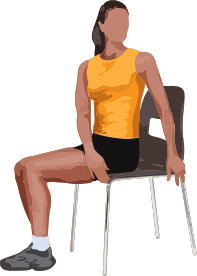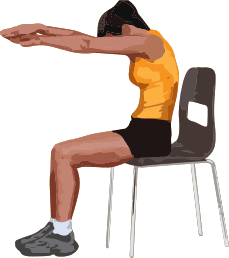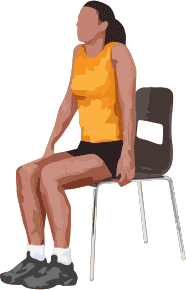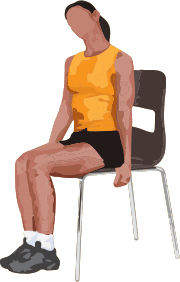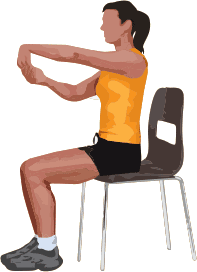Sitting in front of a desk every day can wreak havoc on your body!
Stretching exercises encourage lengthening of your muscles and their associated tendons.
Remember, all stretches should be performed within comfortable limits.
Stretch gradually and hold each stretch once you feel mild muscle tension. Breathe normally while performing stretches and maintain good posture at all times.
Hold each stretch for 10 to 30 seconds. Repeat each stretch 2 to 3 times.
In a seated position with the feet flat on the floor, contract the abs and gently twist the torso towards the right, using your hands to help deepen the stretch.
Only twist as far as you comfortably can and keep the back straight while keeping the hips square.
Hold for 10-30 seconds and repeat on the other side.
Seated or standing, stretch the arms straight out and rotate the hands so that the palms face away from each other.
Cross the arms so that the palms are pressed together, contract the abs and round the back, reaching away as you relax the head.
Don’t collapse but instead imagine you’re curving up and over an imaginary ball.
Hold the stretch for 10-30 seconds. If twisting the arms doesn’t feel good, simply lace the fingers together.
Seated or standing, lift the shoulders up towards the ears, squeezing them as hard as you can.
Hold for 1-2 seconds and roll them back as you relax down.
Repeat for 8-10 reps.
Sitting in your chair, reach down and grab the side of the chair with the right hand and gently pull while tilting your head to the left, feeling a stretch down the right side of the neck and shoulder.
Hold for 10-30 seconds and repeat on the other side.
5. Forearm Stretch
You may not even realise how tight your forearms can get from typing until you stretch them out. This simple move helps stretch those muscles in the forearms and wrists. It is a two part stretch to target the whole forearm.
Part One: Seated or standing, stretch the right arm out and turn the hand down so that the fingers point towards the floor.
Use the left hand to gently pull the fingers towards you, feeling a stretch in the forearm.
Hold for 10-30 seconds and repeat on the other hand.
Part Two: Seated or standing, stretch the right arm out in front of your body with the elbow straight as if you are saying “stop”.
Use the left hand to gently pull the fingers towards you, feeling a stretch in the underside of your forearm.
Hold for 10-30 seconds and repeat on the other hand.
Remedial Massage!
If you would like to know more about our Remedial Massage services and how they can help you, please follow the link.

